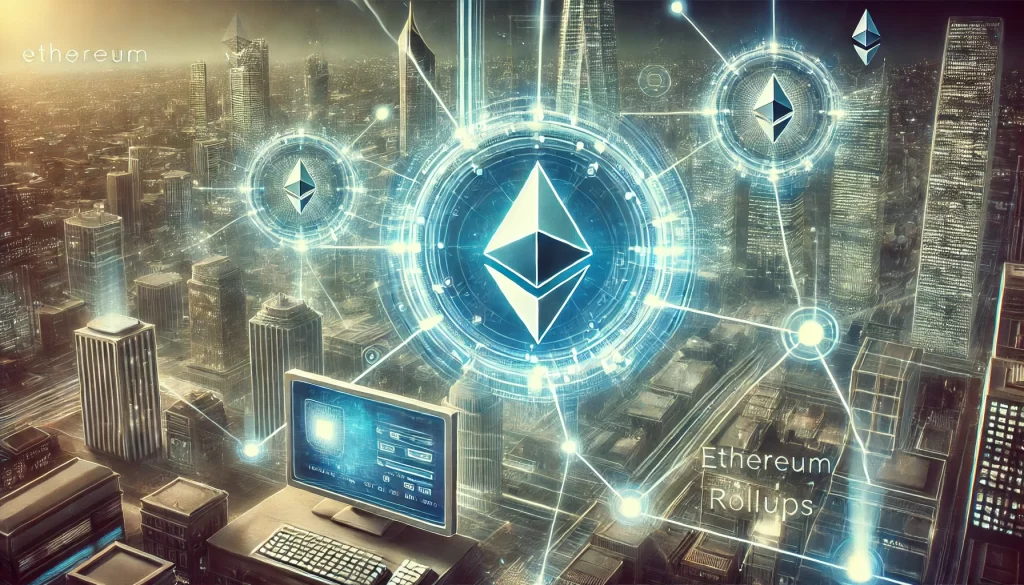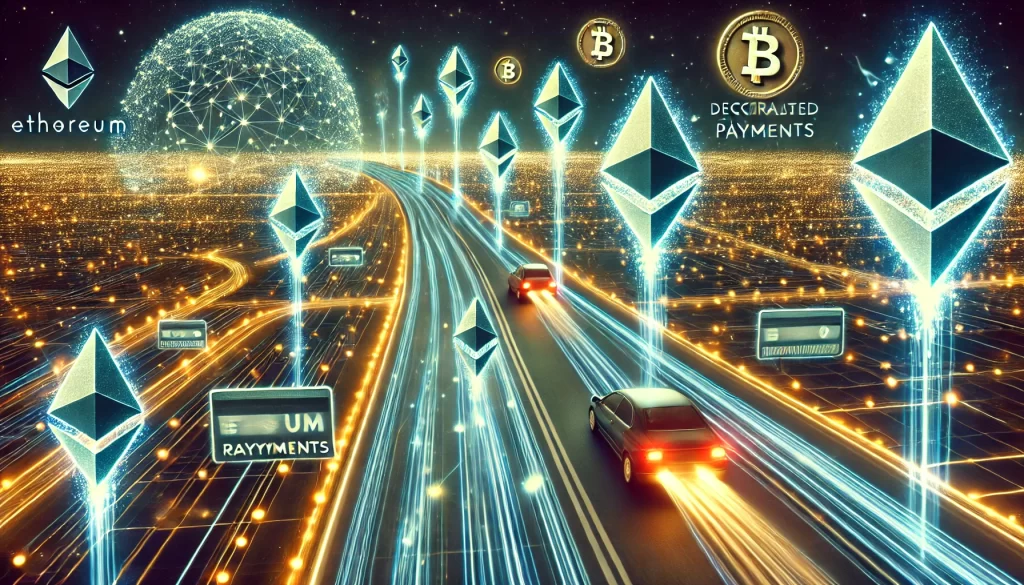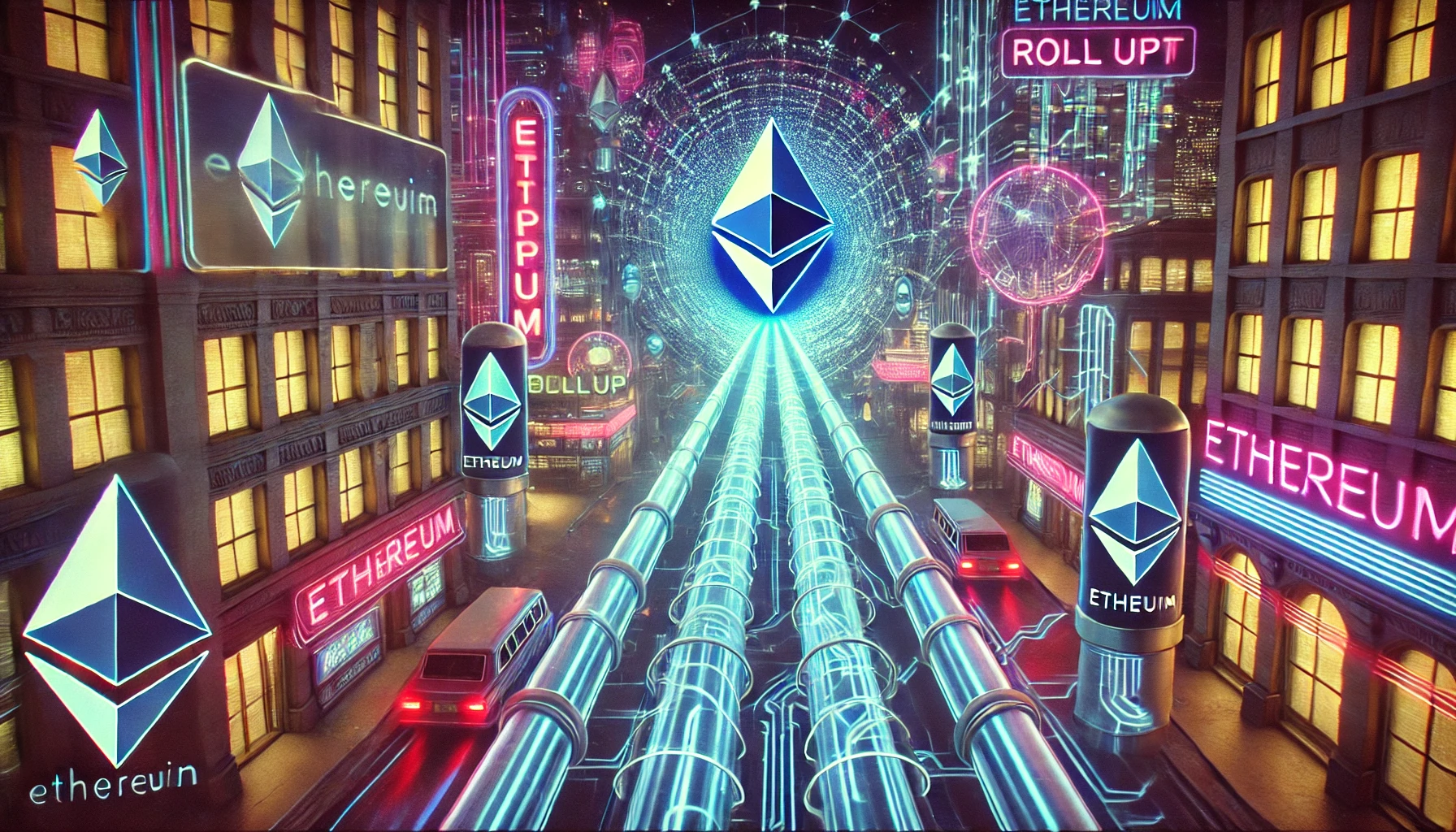AUTHOR: ISTELLA ISSO
Introduction
Ethereum has revolutionized decentralized finance (DeFi), but its growing adoption has led to congestion and high transaction fees. Ethereum rollup payments offer a promising solution by improving scalability without compromising security. In this article, we explore how rollups enhance Ethereum’s payment system and their impact on the crypto space.
Understanding Ethereum Rollups

What Are Rollups in Ethereum?
Rollups in Ethereum are layer-2 scaling solutions that process transactions off-chain while still maintaining Ethereum’s security. They bundle multiple transactions into a single batch and submit them to the Ethereum mainnet, reducing congestion and lowering gas fees. There are two main types: Optimistic Rollups (which assume transactions are valid unless disputed) and Zero-Knowledge (ZK) Rollups (which use cryptographic proofs for instant validation).
How Do Ethereum Rollups Work?
Ethereum rollups work by processing transactions off-chain and then submitting a compressed version of the data to the Ethereum mainnet. This reduces congestion and lowers gas fees while still maintaining security. Transactions are bundled together, verified off-chain, and then finalized on Ethereum using fraud proofs (Optimistic Rollups) or validity proofs (ZK-Rollups). This allows for faster, cheaper, and more scalable transactions without compromising decentralization.
Why Are Rollups Essential for Ethereum?
Rollups are essential for Ethereum because they significantly improve scalability, reduce gas fees, and enhance transaction speed. The Ethereum network often faces congestion, leading to high costs and slow processing times. Rollups help by processing transactions off-chain and submitting only essential data to the mainnet, reducing the burden on Ethereum. This makes decentralized applications (dApps), DeFi, and crypto payments more efficient and accessible, ensuring Ethereum remains competitive as blockchain adoption grows.
Types of Ethereum Rollups
Optimistic Rollups
Optimistic Rollups are a type of Ethereum layer-2 scaling solution that assumes transactions are valid by default and only runs computations if fraud is suspected. They process transactions off-chain and submit a compressed batch to the Ethereum mainnet, reducing gas fees and increasing transaction speed. Since they don’t verify every transaction immediately, they rely on a challenge period where users can submit fraud proofs if any transaction is incorrect.
Benefits and Drawbacks
- Pros: Lower costs, faster transaction processing.
- Cons: Withdrawal delays due to fraud proof verification.
ZK-Rollups (Zero-Knowledge Rollups)
ZK-Rollups (Zero-Knowledge Rollups) are a layer-2 scaling solution for Ethereum that uses cryptographic proofs to verify transactions instantly. Ethereum payment gateway[1] Instead of assuming transactions are valid like Optimistic Rollups, ZK-Rollups generate validity proofs (zero-knowledge proofs) that confirm all transactions are correct before submitting them to the Ethereum mainnet. This ensures faster finality, lower gas fees, and enhanced security.
Advantages and Challenges
- Pros: Instant transaction settlement, improved privacy.
- Cons: Complex implementation, high computational costs.
Benefits of Ethereum Rollup Payments
Faster Transactions
Ethereum rollups [2] enable faster transactions by processing them off-chain and submitting only compressed data to the mainnet. ZK-Rollups offer instant finality with cryptographic proofs, while Optimistic Rollups require a short challenge period. This reduces congestion, lowers gas fees, and makes Ethereum transactions quicker and more efficient.
Lower Gas Fees
Ethereum rollups lower gas fees by bundling multiple transactions into a single batch before submitting them to the mainnet. Blockchain Rollups[3]This reduces the amount of data processed on-chain, significantly cutting costs. Optimistic Rollups and ZK-Rollups both help users save on fees, making Ethereum transactions more affordable and scalable for everyday use.
Enhanced Security
Ethereum rollups provide enhanced security by inheriting the robust security of the Ethereum mainnet. ZK-Rollups use cryptographic validity proofs to ensure transactions are correct before submission, while Optimistic Rollups rely on fraud proofs to detect invalid transactions. Blockchain Rollups Solutions[4] This ensures secure, tamper-proof transactions while improving scalability.

Greater Decentralization
Ethereum rollups contribute to greater decentralization by reducing reliance on the congested mainnet while still maintaining Ethereum’s security. Roll Up Strategy[5] By enabling faster, cheaper transactions, rollups allow more users to participate in DeFi and d Apps without needing expensive gas fees. This strengthens Ethereum’s ecosystem, making it more inclusive and censorship-resistant.
Ethereum Rollup Payment Solutions
Popular Rollup Solutions
Popular Ethereum rollup solutions include Arbitrum and Optimism (Optimistic Rollups), which assume transactions are valid unless disputed, and zkSync, StarkNet, and Polygon zkEVM (ZK-Rollups), which use cryptographic proofs for instant validation. These solutions enhance scalability, reduce gas fees, and improve transaction speeds on Ethereum.
- Arbitrum – Known for high compatibility with Ethereum.
- Optimism – Provides seamless developer integration.
- zkSync – Offers fast finality with zero-knowledge proofs.
- StarkNet – Delivers advanced cryptographic security.
How These Solutions Improve Payment Efficiency
Popular Ethereum rollup solutions include Arbitrum and Optimism (Optimistic Rollups), which assume transactions are valid unless disputed, and zkSync, StarkNet, and Polygon zkEVM (ZK-Rollups), which use cryptographic proofs for instant validation. These solutions enhance scalability, reduce gas fees, and improve transaction speeds on Ethereum.
How to Use Rollups for Payments
Setting Up a Wallet for Rollup Transactions
To set up a wallet for rollup transactions, use MetaMask, Trust Wallet, or Coinbase Wallet. Add the Arbitrum, Optimism, or zkSync network in your wallet settings, then bridge funds from Ethereum to the rollup. You can now enjoy faster, cheaper transactions on supported dApps and DeFi platforms.
Sending and Receiving Payments via Rollups
- Choose a rollup-enabled network (e.g., Arbitrum, Optimism).
- Fund the wallet with ETH or ERC-20 tokens.
- Send transactions with minimal fees and near-instant confirmation.
Integration with Businesses and Merchants
Integrating rollups with businesses and merchants enables faster, low-cost crypto payments, but adoption remains slow due to technical complexity and liquidity challenges. Seamless payment gateways and better merchant tools are essential for driving mainstream rollup adoption in commerce.
Challenges and Limitations of Rollup Payments
Liquidity Issues
Liquidity issues in rollups can occur when there’s limited liquidity available for bridging assets between Ethereum and layer-2 networks. This scarcity may lead to increased slippage or delays during token transfers. Addressing these challenges is vital for ensuring smooth and efficient transactions on rollup platforms.
Complexity of Implementation
The complexity of implementation in rollups comes from advanced cryptographic proofs (ZK-Rollups) and fraud detection mechanisms (Optimistic Rollups). Developers must modify dApps for compatibility, and managing rollup infrastructure requires expertise. Simplifying integration is crucial for wider adoption and scalability.
Adoption Barriers
Adoption barriers for rollups include complexity, limited awareness, and smart contract compatibility issues. Users may find bridging funds and switching networks challenging, while some dApps require modifications to function efficiently. Overcoming these hurdles is key to wider rollup adoption and Ethereum scalability.
Future of Ethereum Rollup Payments

Upcoming Developments in Rollup Technology
Upcoming rollup developments focus on better scalability, lower fees, and enhanced security. Innovations like ZK-EVMs will improve smart contract compatibility, while decentralized sequencers will reduce centralization risks. These advancements will make Ethereum rollups faster, cheaper, and more accessible for global adoption.
How Rollups Fit into Ethereum 2.0 and Beyond
Rollups are essential for Ethereum 2.0 and beyond, complementing upgrades like sharding to improve scalability. By processing transactions off-chain, rollups reduce congestion and lower fees while maintaining security. They will play a key role in Ethereum’s future, enabling faster, more efficient blockchain adoption worldwide.
The Role of Rollups in Global Crypto Payments
Rollups play a crucial role in global crypto payments by enabling faster, low-cost transactions while maintaining Ethereum’s security. They reduce gas fees and processing times, making crypto payments more efficient and accessible for users and businesses worldwide. This helps drive mass adoption of digital currencies for everyday transactions.
Conclusion
Ethereum rollup payments are transforming blockchain transactions by offering faster speeds, lower costs, and improved scalability while maintaining security. By processing transactions off-chain and submitting only necessary data to Ethereum, rollups reduce congestion and make crypto payments more efficient. Solutions like Optimistic Rollups and ZK-Rollups enable seamless transactions for dApps, DeFi, and global commerce.
FAQs
1. What is the main difference between Optimistic Rollups and ZK-Rollups?
Optimistic Rollups assume transactions are valid until challenged, while ZK-Rollups use cryptographic proofs for immediate validation.
2. Are Ethereum Rollups secure for payments?
Yes, they inherit Ethereum’s security model and provide enhanced fraud protection.
3. Can businesses integrate Rollup payments easily?
Yes, many rollup solutions offer APIs and tools for seamless merchant integration.
4. Do Rollups completely eliminate gas fees?
No, but they significantly reduce them compared to traditional Ethereum transactions.
5. How can I start using Rollups for payments today?
Set up a compatible wallet, choose a rollup network, and start transacting with lower fees.

